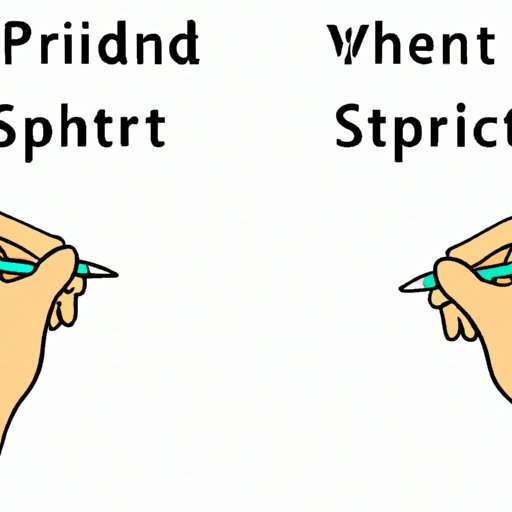Introduction
Writing in the third person is a form of storytelling where the narrator is not a character in the story, but instead an outside entity that observes and narrates the events of the story. It is often used in fiction, as well as in nonfiction, to create a sense of objectivity and distance from the characters and events. Writing in the third person can be both a challenging and rewarding experience for authors, allowing them to explore different points of view and craft compelling stories.
Step-by-Step Guide to Writing in the Third Person
When it comes to writing in the third person, there are several steps to consider. First, you need to decide on a narrative voice and point of view. Once these have been established, you can begin crafting the story. Here is a step-by-step guide to writing in the third person:
How to Choose a Narrative Voice
The narrative voice is the author’s perspective from which the story is told. When writing in the third person, the author is not a character in the story, so the narrative voice will be that of an outside observer. There are two common narrative voices when writing in the third person: limited and omniscient.
In a limited third person narrative, the narrator has access to one character’s thoughts, feelings, and actions. This point of view allows the reader to become intimately familiar with one character, while still maintaining some distance from the other characters. An omniscient third person narrative, on the other hand, gives the narrator access to all characters’ thoughts, feelings, and actions. This point of view allows the reader to understand all characters equally, creating a more objective view of the story.
Crafting the Story
Once you have chosen your narrative voice, you can begin crafting the story. Depending on the type of story you are writing, this may involve developing characters, researching settings, or exploring themes. The goal is to create a vivid and engaging narrative that draws readers in and keeps them hooked until the end.
Exploring Point of View
A key component of writing in the third person is exploring point of view. Point of view refers to the perspective from which the story is told. In a third person narrative, the point of view can be either limited or omniscient, depending on the narrative voice you have chosen. It is important to consider how the point of view affects the story and the characters, as this can shape the way readers interpret the events of the story.
Examples of Third Person Writing
Third person writing can be found in both fiction and nonfiction. Here are some examples of third person writing:
Fiction
In fiction, third person writing is often used to create a sense of objectivity and distance from the characters. For example, Leo Tolstoy’s novel Anna Karenina is written in the third person, with the narrator providing an impartial view of the characters and their actions. Similarly, J.K. Rowling’s Harry Potter series is written in the third person, allowing readers to observe the events of the story without feeling too close to any of the characters.
Nonfiction
In nonfiction, third person writing can be used to provide an unbiased account of a particular event or subject. For example, historian David McCullough’s book 1776 is written in the third person, providing readers with a detailed account of the American Revolution without taking sides in the conflict. Similarly, journalist John Hersey’s Hiroshima is written in the third person, giving readers a balanced view of the tragedy and its impact.

Tips for Crafting a Narrative in the Third Person
Crafting a compelling narrative in the third person requires careful consideration of the narrative voice, point of view, and characters. Here are some tips for crafting a narrative in the third person:
Choosing a Narrative Voice
When writing in the third person, it is important to choose a narrative voice that best fits the story. Consider whether a limited or omniscient point of view would be more effective, and make sure to keep the narrative voice consistent throughout the story.
Developing Characters
When writing in the third person, it is important to develop fully realized characters. Give each character a unique voice and personality, and make sure to include enough details to make them feel real to the reader.
Showing Character Development
As the story progresses, make sure to show how the characters grow and change. Showing characters’ growth and development adds depth and complexity to the story, and makes it more engaging for readers.
Establishing Setting
The setting of the story is just as important as the characters. When writing in the third person, make sure to establish the time and place of the story, and to include enough details to create a vivid and immersive experience for readers.

How to Avoid Common Mistakes When Writing in the Third Person
Writing in the third person can be tricky, and it is easy to make mistakes if you are not careful. Here are some tips for avoiding common mistakes when writing in the third person:
Overuse of Passive Voice
When writing in the third person, it is important to avoid using too much passive voice. Passive voice can make the writing dull and lifeless, and can make it difficult for readers to follow the story. Instead, use active voice to make the writing more dynamic and engaging.
Not Establishing Point of View
When writing in the third person, it is important to establish the point of view early on. If the point of view is unclear, readers may become confused and frustrated. Make sure to clearly establish the narrative voice and point of view, and to maintain consistency throughout the story.
Using Too Many Details
While it is important to include enough details to create a vivid and engaging narrative, it is also important to avoid including too many details. Too many details can bog down the narrative and make it difficult for readers to follow the story. Instead, focus on the essential details and omit anything that is not necessary.

Writing in the Third Person vs. Writing in the First Person
When it comes to writing a story, authors must decide whether to write in the third person or the first person. While both perspectives have their advantages and disadvantages, there are some key differences between the two. Here is a look at the differences between writing in the third person and writing in the first person:
Differences Between the Two
The most obvious difference between writing in the third person and writing in the first person is the point of view. In a third person narrative, the narrator is an outside entity that observes and narrates the events of the story. In a first person narrative, the narrator is a character in the story, providing a firsthand account of the events.
Pros and Cons of Each
Writing in the third person can be beneficial for authors who want to create a sense of objectivity and distance from the characters and events. On the other hand, writing in the first person can be beneficial for authors who want to create a more personal connection with readers. Ultimately, the decision of which point of view to use should come down to the type of story you are trying to tell.
Conclusion
Writing in the third person can be a challenging and rewarding experience for authors. It requires careful consideration of the narrative voice, point of view, and characters. By understanding what writing in the third person means and following the steps outlined in this guide, authors can craft compelling stories that draw readers in and keep them hooked until the end.
When writing in the third person, it is important to choose a narrative voice and point of view that best fits the story. Additionally, it is important to develop fully realized characters, show character development, and establish a vivid setting. Finally, it is important to avoid common mistakes such as overusing passive voice, failing to establish point of view, and using too many details.
Writing in the third person is different from writing in the first person, as it allows authors to create a sense of objectivity and distance from the characters and events. Ultimately, the decision of which point of view to use should come down to the type of story you are trying to tell.
(Note: Is this article not meeting your expectations? Do you have knowledge or insights to share? Unlock new opportunities and expand your reach by joining our authors team. Click Registration to join us and share your expertise with our readers.)
